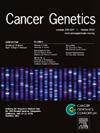59. What the TERT? - A telomerase reverse transcriptase case study
IF 1.4
4区 医学
Q4 GENETICS & HEREDITY
引用次数: 0
Abstract
Telomerase reverse transcriptase is a catalytic subunit of the telomerase protein that is involved in the maintenance of genomic stability. TERT aberrations are important biomarkers in the diagnosis, prognosis, and treatment of many human cancers. The TERT promoter has proven to be a difficult region of testing amongst a variety of currently available technologies.
TERT promoter mutation analysis was performed on brain tissue of a 62-year old male meningioma patient using MALDI-TOF (Agena Bioscience MassARRAY platform) and detected a low frequency TERT mutation. The pathologist questioned the result and sent some of the sample for additional testing to 2 different referral laboratories - one aliquot was sent for Pyrosequencing and the other for NGS - both with a higher limit of detection than MALDI-TOF. Neither methodology detected a TERT mutation. On the basis of these result the diagnosis was changed.
Certain of our TERT mutation, an aliquot of the remaining extracted DNA was sent for digital droplet PCR (ddPCR) which has the same limit of detection as our MALDI-TOF platform. A TERT mutation was confirmed.
This case highlights the challenges in TERT promoter mutation analysis as well as the significance of confirmatory testing. The importance of confirming results using platforms with an appropriate limit of detection is paramount in reducing under-reporting of low level mutations of clinical significance.
59.什么是 TERT?- 端粒酶逆转录酶案例研究
端粒酶逆转录酶是端粒酶蛋白的催化亚基,参与维持基因组的稳定性。TERT畸变是诊断、预后和治疗许多人类癌症的重要生物标志物。使用 MALDI-TOF(Agena Bioscience MassARRAY 平台)对一名 62 岁男性脑膜瘤患者的脑组织进行了 TERT 启动子突变分析,检测到了低频 TERT 突变。病理学家对这一结果提出质疑,并将部分样本送往两个不同的转诊实验室进行额外检测,其中一个样本被送往热测序实验室,另一个样本被送往 NGS 实验室,这两个实验室的检测限均高于 MALDI-TOF。两种方法都没有检测到 TERT 突变。在这些结果的基础上,我们改变了诊断。在确定了 TERT 突变后,我们将剩余提取的 DNA 样本送去进行数字液滴 PCR (ddPCR),其检测限与我们的 MALDI-TOF 平台相同。该病例凸显了 TERT 启动子突变分析所面临的挑战以及确证检测的重要性。使用具有适当检测限的平台确认结果对于减少具有临床意义的低水平突变的漏报至关重要。
本文章由计算机程序翻译,如有差异,请以英文原文为准。
求助全文
约1分钟内获得全文
求助全文
来源期刊

Cancer Genetics
ONCOLOGY-GENETICS & HEREDITY
CiteScore
3.20
自引率
5.30%
发文量
167
审稿时长
27 days
期刊介绍:
The aim of Cancer Genetics is to publish high quality scientific papers on the cellular, genetic and molecular aspects of cancer, including cancer predisposition and clinical diagnostic applications. Specific areas of interest include descriptions of new chromosomal, molecular or epigenetic alterations in benign and malignant diseases; novel laboratory approaches for identification and characterization of chromosomal rearrangements or genomic alterations in cancer cells; correlation of genetic changes with pathology and clinical presentation; and the molecular genetics of cancer predisposition. To reach a basic science and clinical multidisciplinary audience, we welcome original full-length articles, reviews, meeting summaries, brief reports, and letters to the editor.
 求助内容:
求助内容: 应助结果提醒方式:
应助结果提醒方式:


